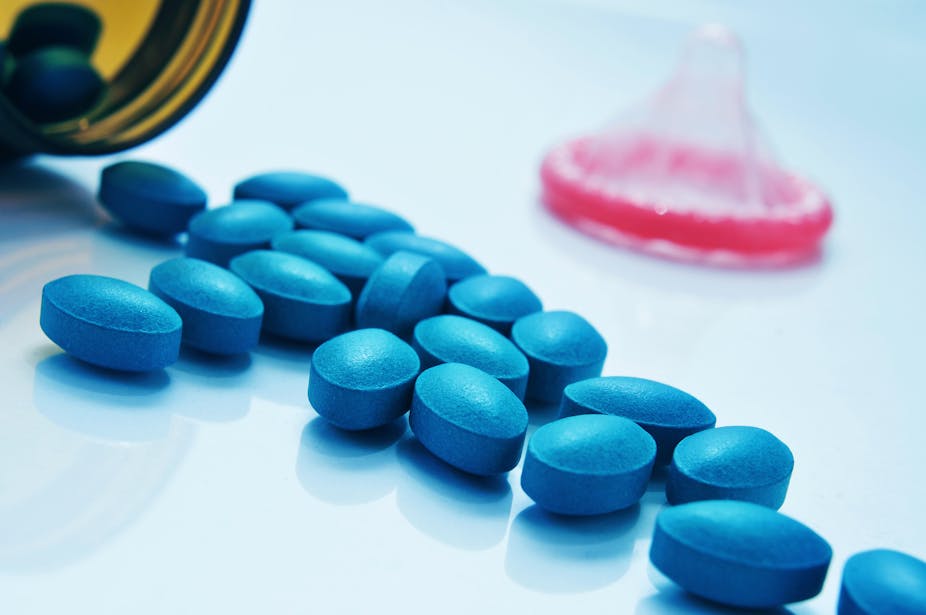A pill a day can prevent HIV, but there’s no guarantee Australians will get access to this intervention anytime soon. Pre-exposure prophylaxis, or PrEP for short, is the use of antiretroviral drugs in HIV-negative people to prevent them from acquiring HIV. It’s approved in the United States but not in Australia.
PreP is a combination of two antiretroviral drugs that works by disabling HIV replication in cells exposed to HIV with sex (in the rectum, penis or vagina). When HIV can’t replicate, the infection dies off at the infection site. And this prevents HIV from spreading through body systems and integrating with host DNA.
The drug has been tested on its own and in combination with another antiretroviral in randomised control trials, and in “implementation studies”. These are studies that test the intervention under conditions closer to real life to determine their safety and efficacy. The therapy has been found to be highly effective, more so for those who take it consistently and in the correct dosage.
Good for some
In 2012, the United States Food and Drug Administration (FDA) approved PrEP for use in combination with safer sex practices for adults at high risk of contracting HIV. And last year, the World Health Organization (WHO) issued guidelines stating that PrEP should be available to all men who have sex with men, transgendered women who have sex with men, and women and men who are HIV-negative and in a sexual relationship with HIV-positive partners.
There are two key issues to note from the FDA and WHO. The first is that PrEP is intended to be used as an adjunct to other forms of HIV prevention rather than a substitute. And secondly, the evidence to date shows PrEP isn’t equally appropriate for all people at risk of HIV.
For people whose risk of HIV is through injecting drug use, for example, an antiretroviral-based oral drug is no substitute for the needle and syringe programs that provide protection from a range of blood-borne viruses.
And sex workers have raised the issue of its impact on their work. Australian sex worker groups have articulated concerns that PrEP could undermine safer sex practices that are critical to work health and safety in the sex industry – namely, non-negotiable condom use, which is highly protective against a range of sexually transmissible infections as well as HIV.
Thus, PrEP is not necessarily desirable for all populations at increased risk of HIV.
For gay men and other men who have sex with men, transgendered women and HIV-negative people in relationships with HIV-positive people, however, the evidence shows PrEP could be of great value. These people face increased risk of getting HIV because consistent perfect condom use over a lifetime of sexual activity is unlikely.
Sticking point

Currently, the FDA is the only national authority to have approved PrEP, though countries such as South Africa and Australia have produced clinical guidelines on its use.
That means Australians seeking PrEP have three options: first, they can join implementation studies in New South Wales, Victoria and Queensland, with 500 places available over all. But both the NSW and the Victorian sites are fully enrolled so to join a trial they’d need to move to Queensland.
Second, they could obtain an “off-label” prescription from their doctor and pay about A$850 per month; or they could obtain a prescription from their doctor and personally import the generic version of the drug, at an estimated cost of A$120-$130 per month.
The drug’s manufacturer, Gilead Sciences submitted an application for the combined drug to be approved by Australian drug regulator Therapeutic Goods Administration (TGA) for HIV prevention earlier this year. That approval is expected by mid-2016, but that’s only one step in making the drug broadly available.
The company also has to make an application to the Pharmaceutical Benefits Advisory Committee (PBAC) to get the drug listed on the Pharmaceutical Benefits Scheme (PBS) so it can be subsidised.
It is possible for the TGA and the PBAC submission to be made concurrently, but Gilead has not taken this option. The PBAC listing process could take 18 months or more, and it’s not certain the company will even apply for PBAC listing. It hasn’t definitely committed to taking that step, stating only that it will “fully assess the potential for a successful PBAC submission” once the TGA approval is through.
Cost barriers?
Patents for the two component drugs of PrEP expire in 2017 and 2021, which could have a bearing on the cost of the combined drug in the future. And on Gilead’s decision about whether to apply to have the drug listed on the PBS. In the meantime, around 1,200 people in Australia acquire HIV each year.
PrEP is not a magic bullet for HIV prevention; it’s too expensive for people at low risk of acquiring HIV. And it’s not desirable for injecting drug users and sex workers. But for people at risk of acquiring HIV who don’t consistently use condoms, it offers a new way to reduce the risk. Those at risk can take prevention in their own hands.
The therapy also enables HIV prevention to be separated from sex itself.
These are qualities shared by the oral contraceptive pill – another paradigm changer for sexual health. Timely, well-targeted access to PrEP should therefore be considered a priority for HIV prevention.

